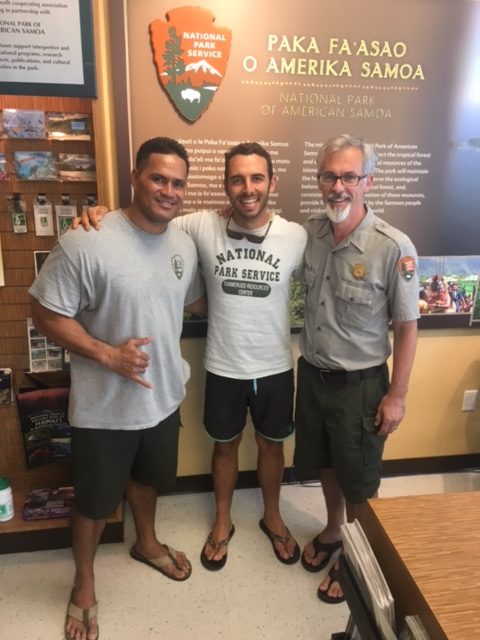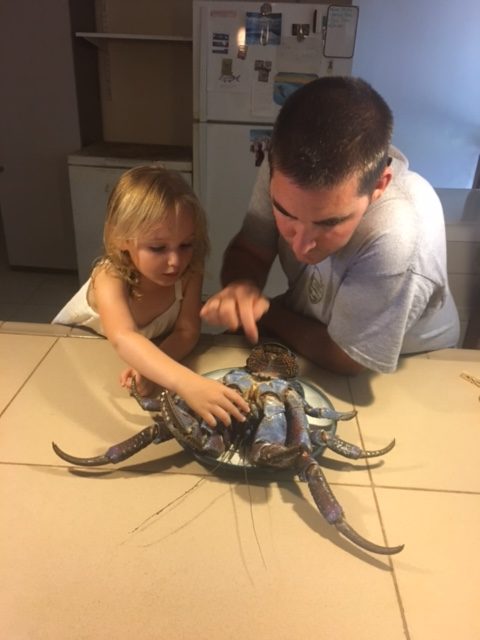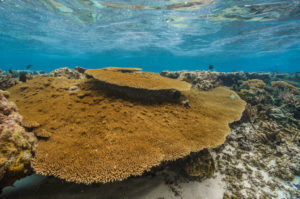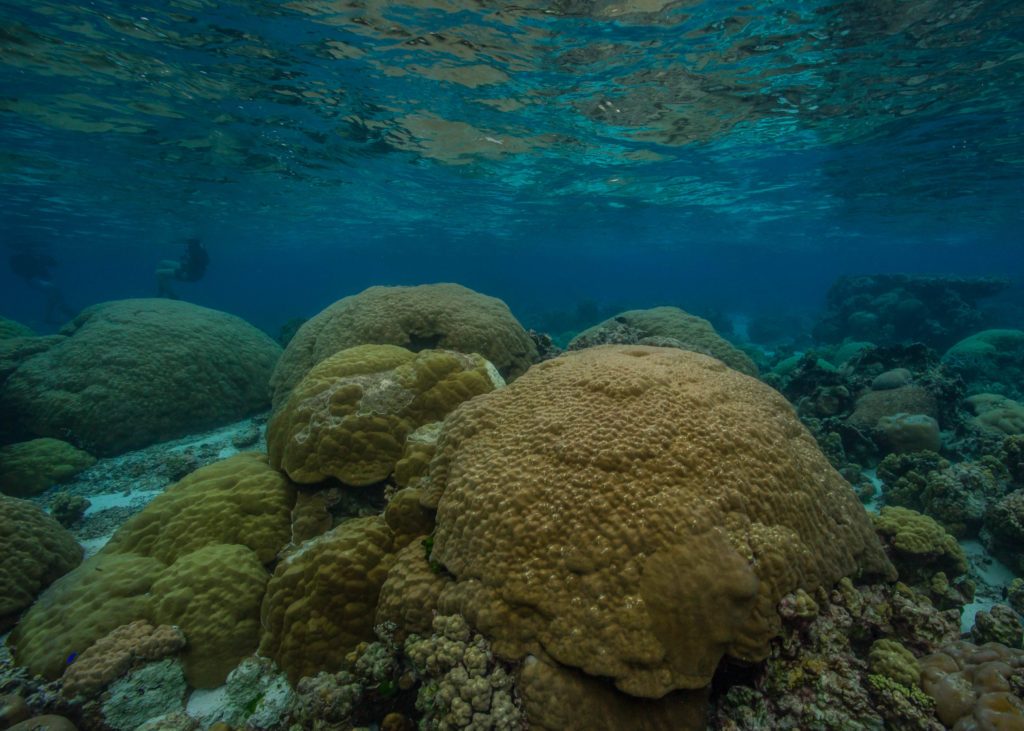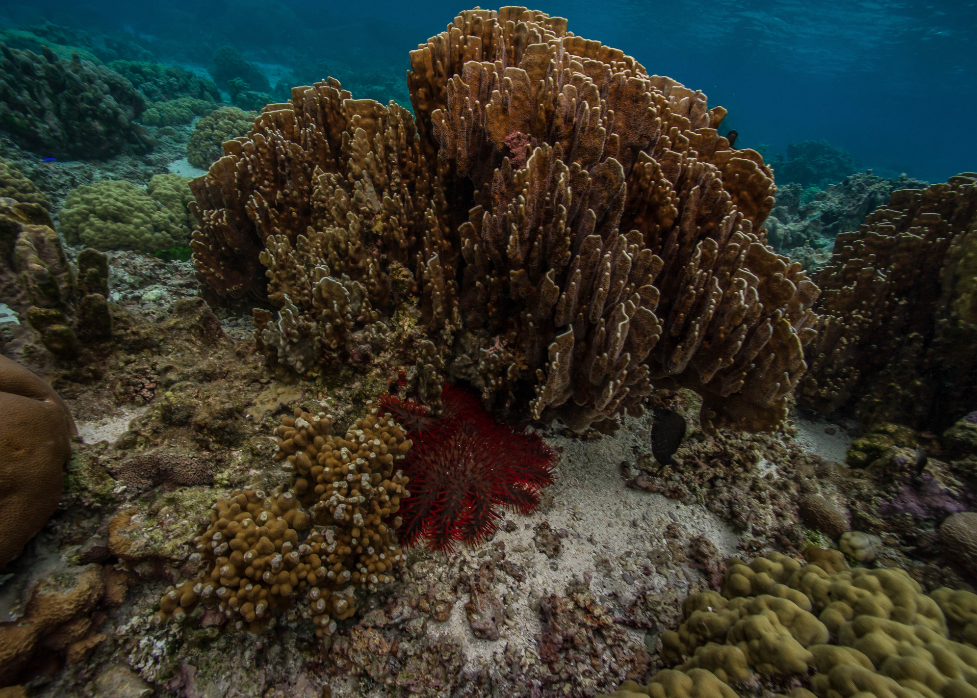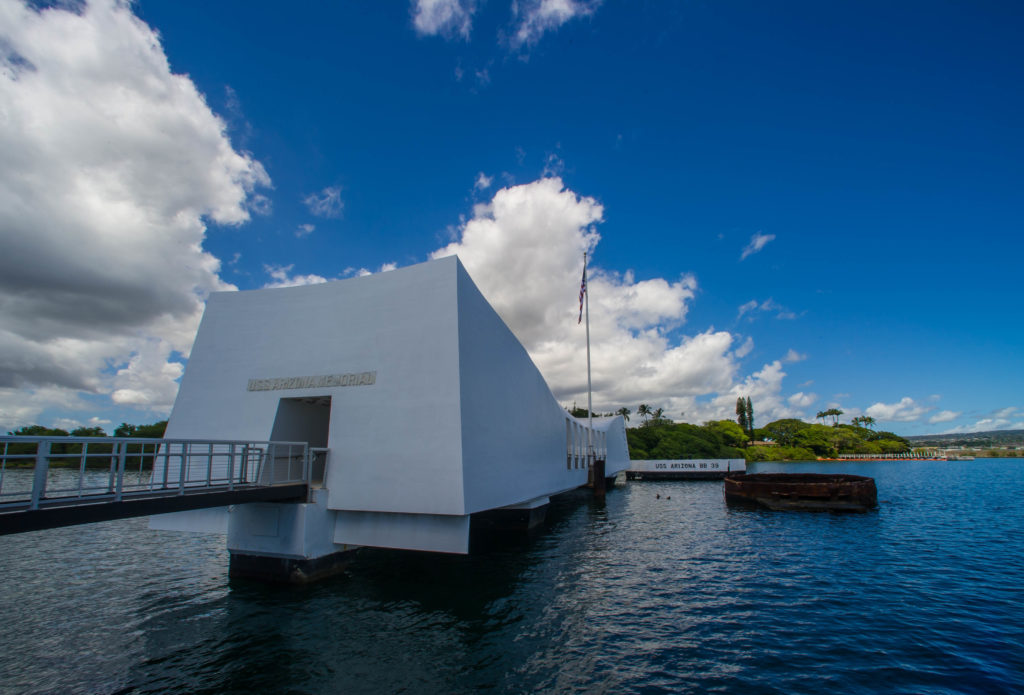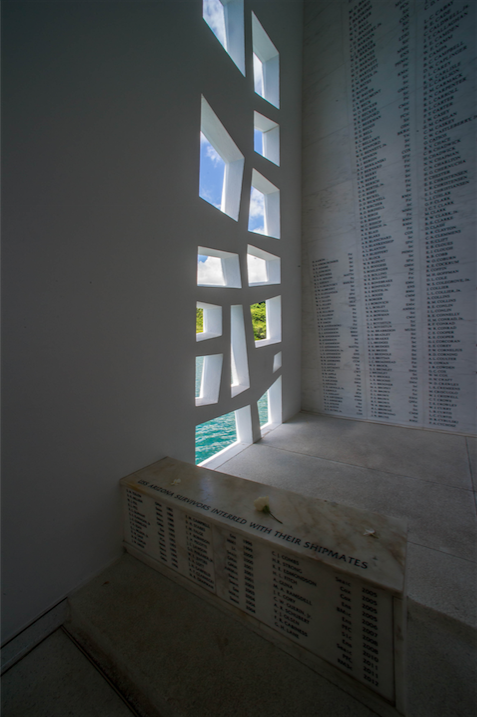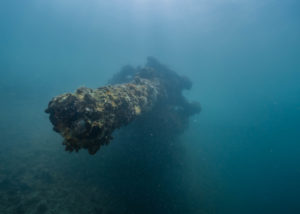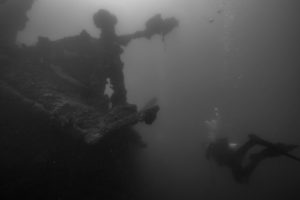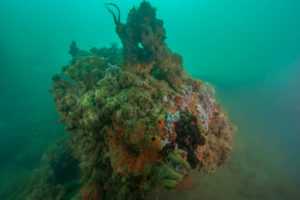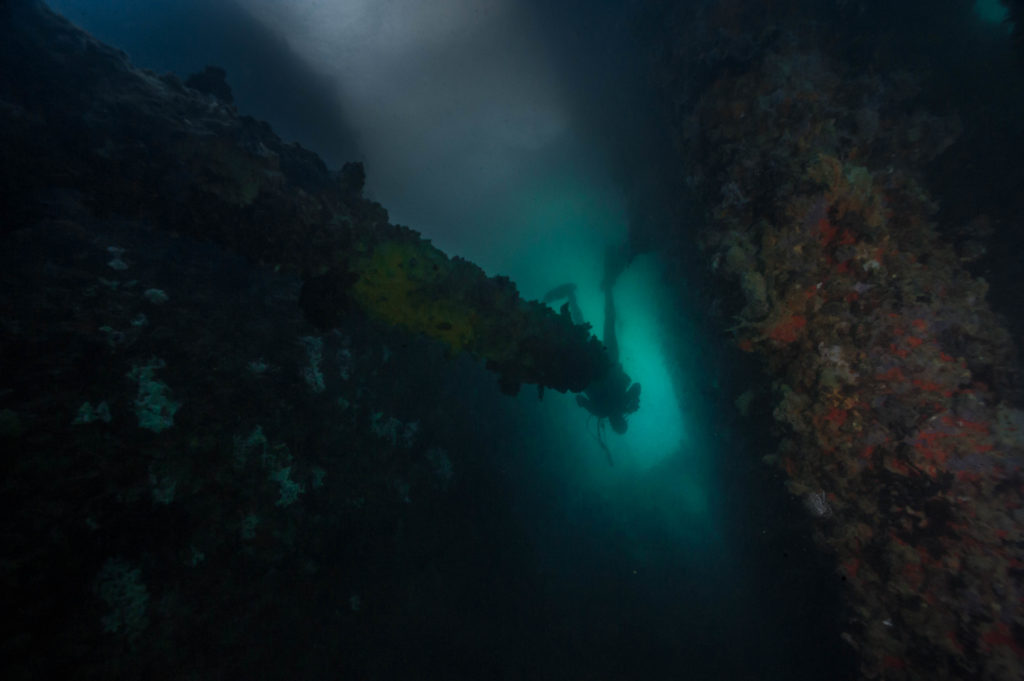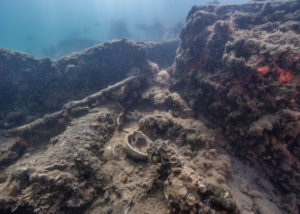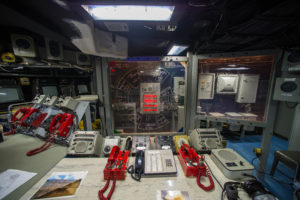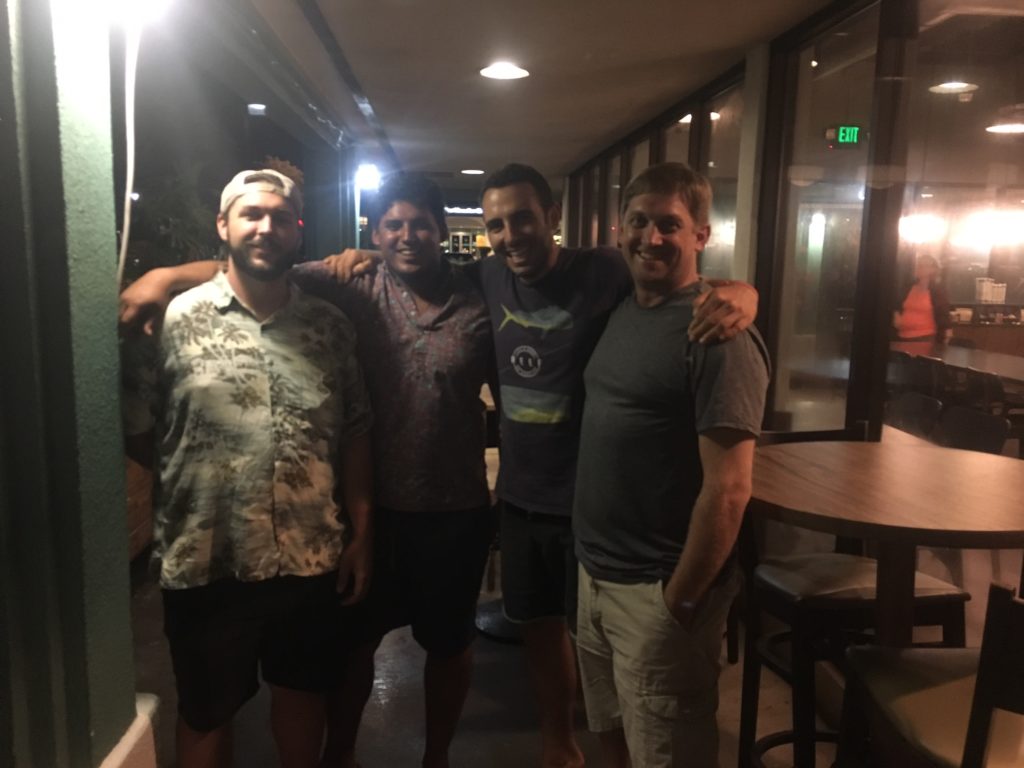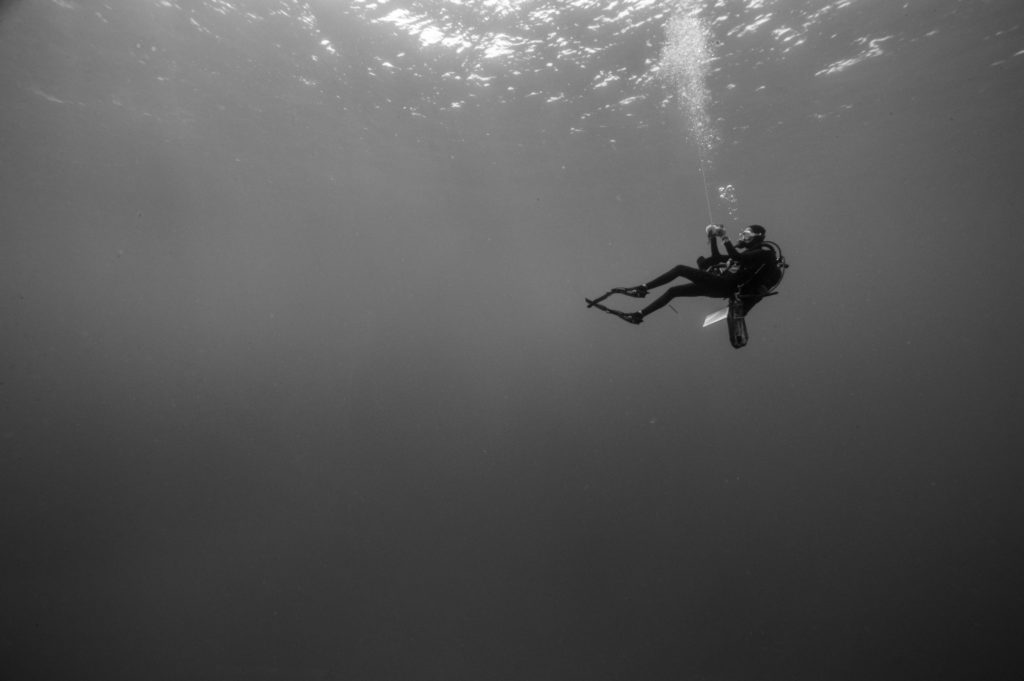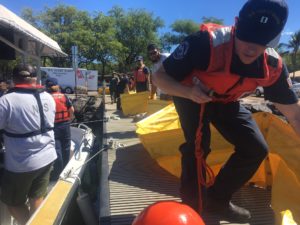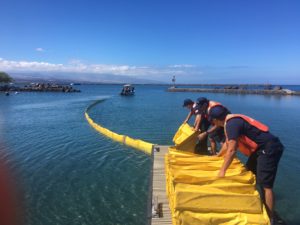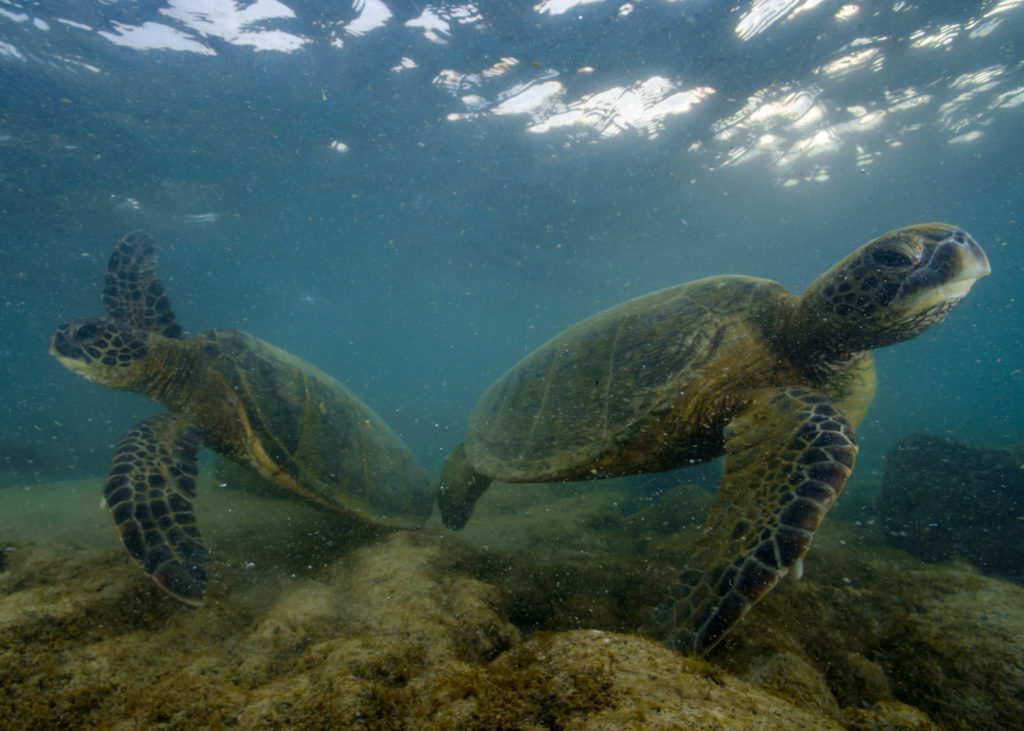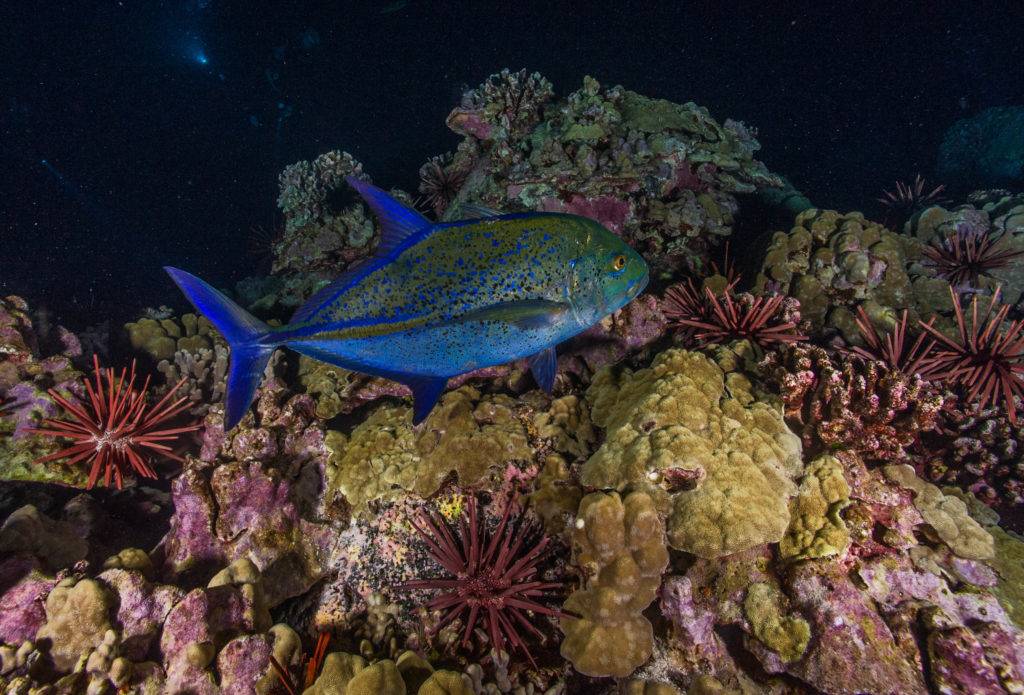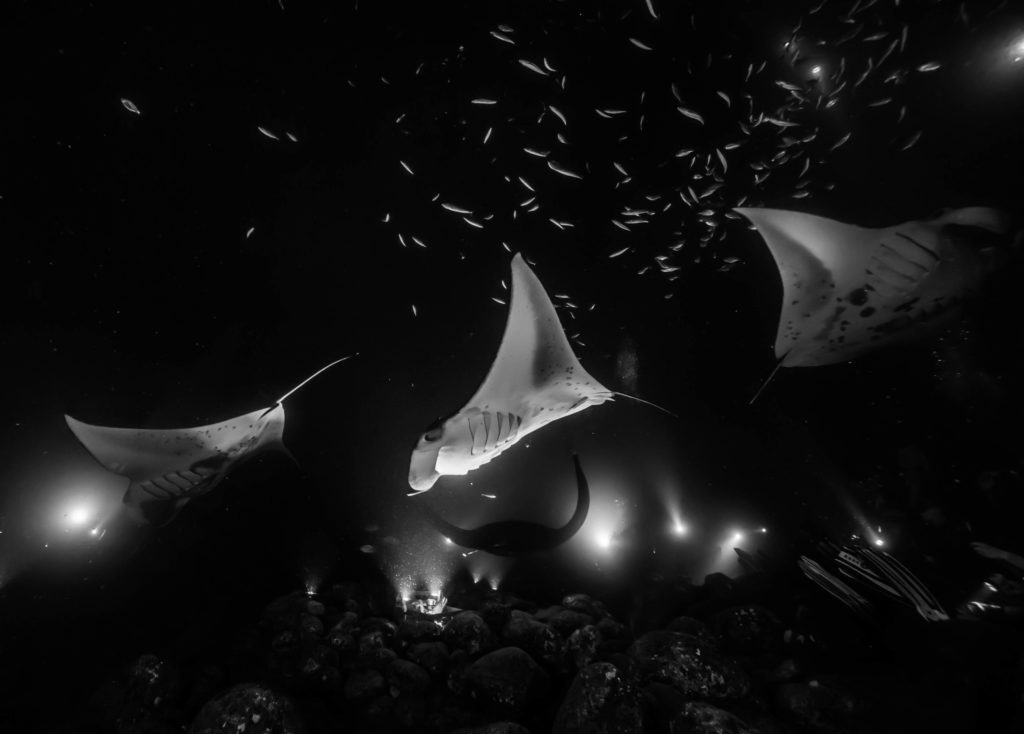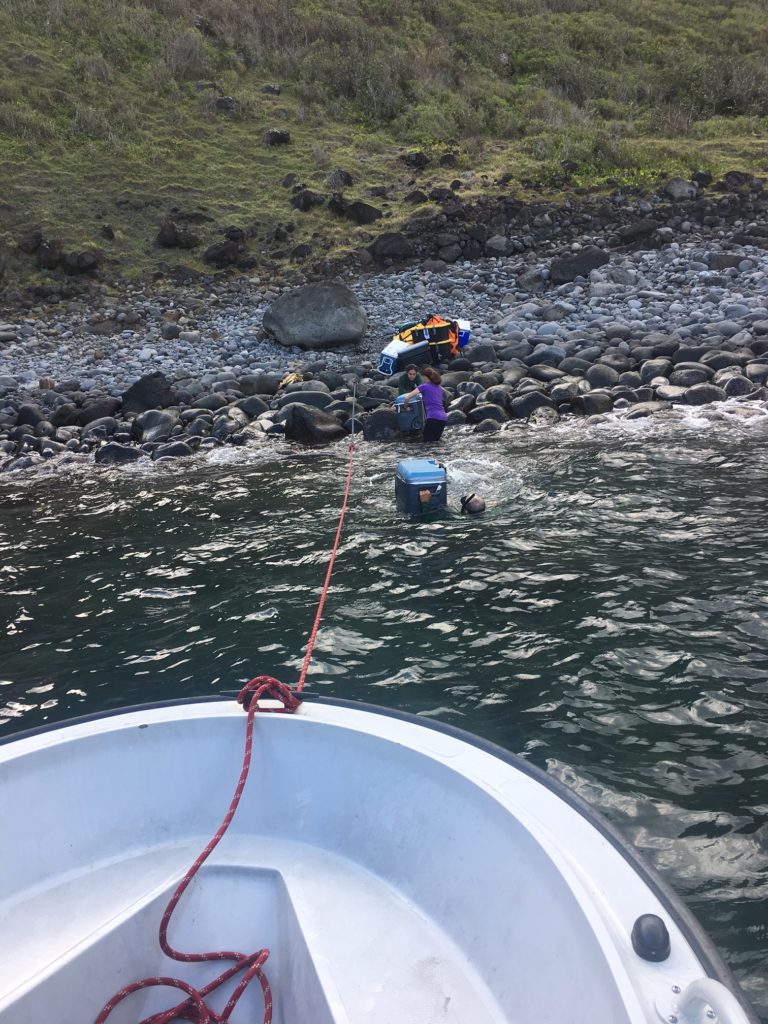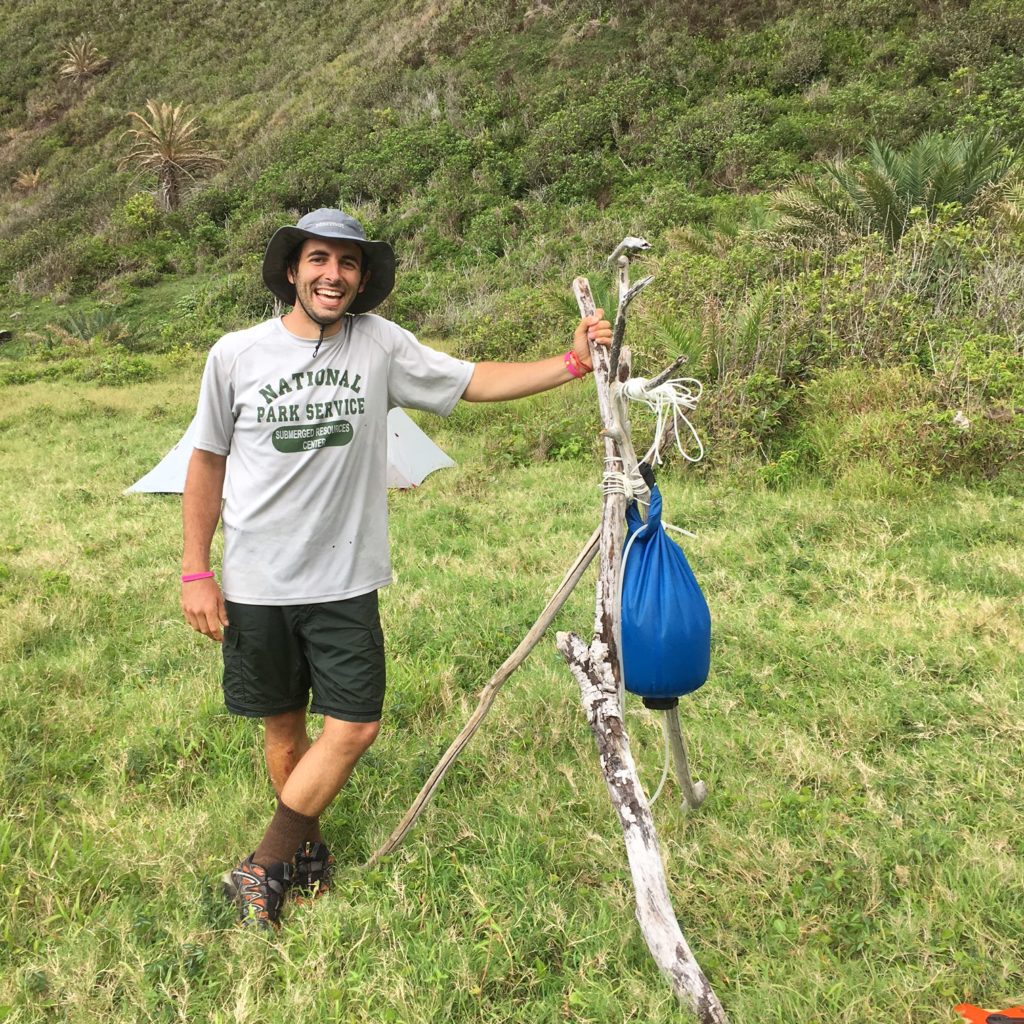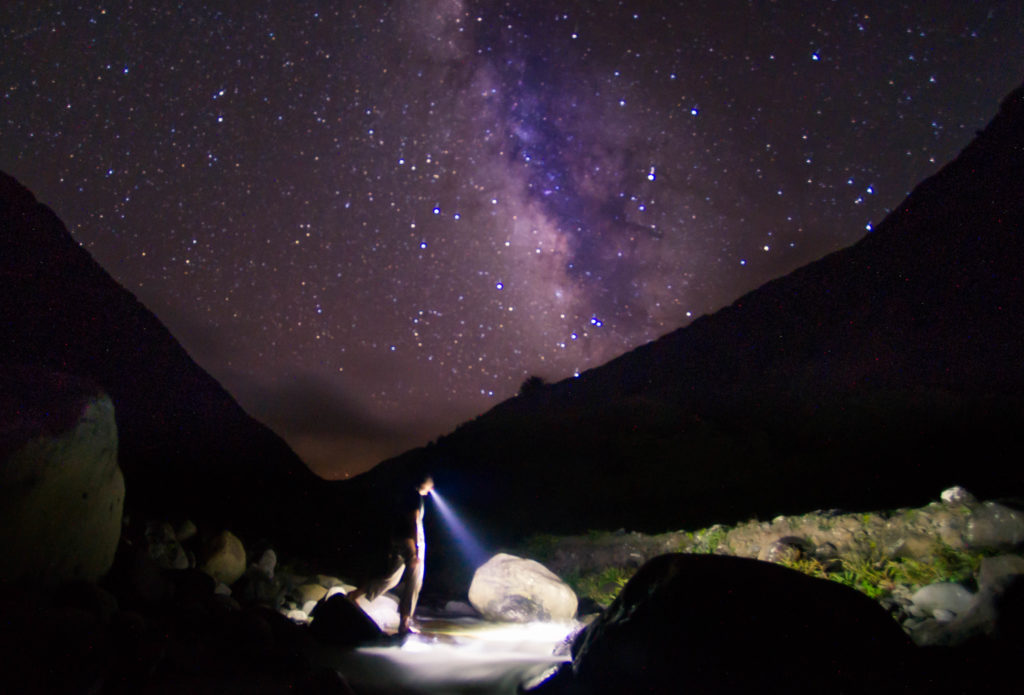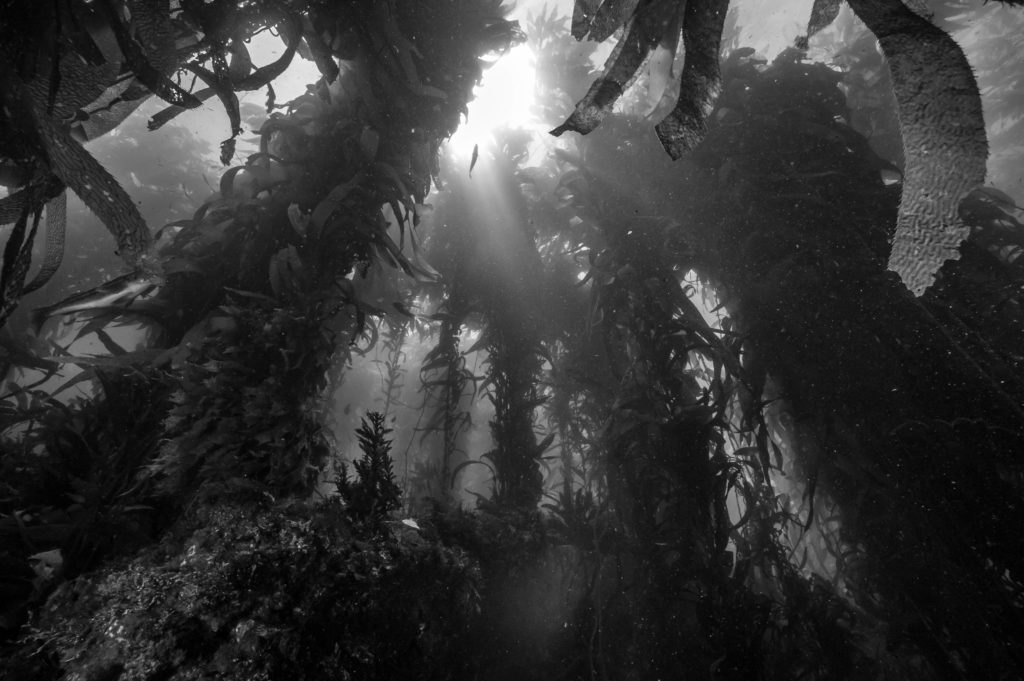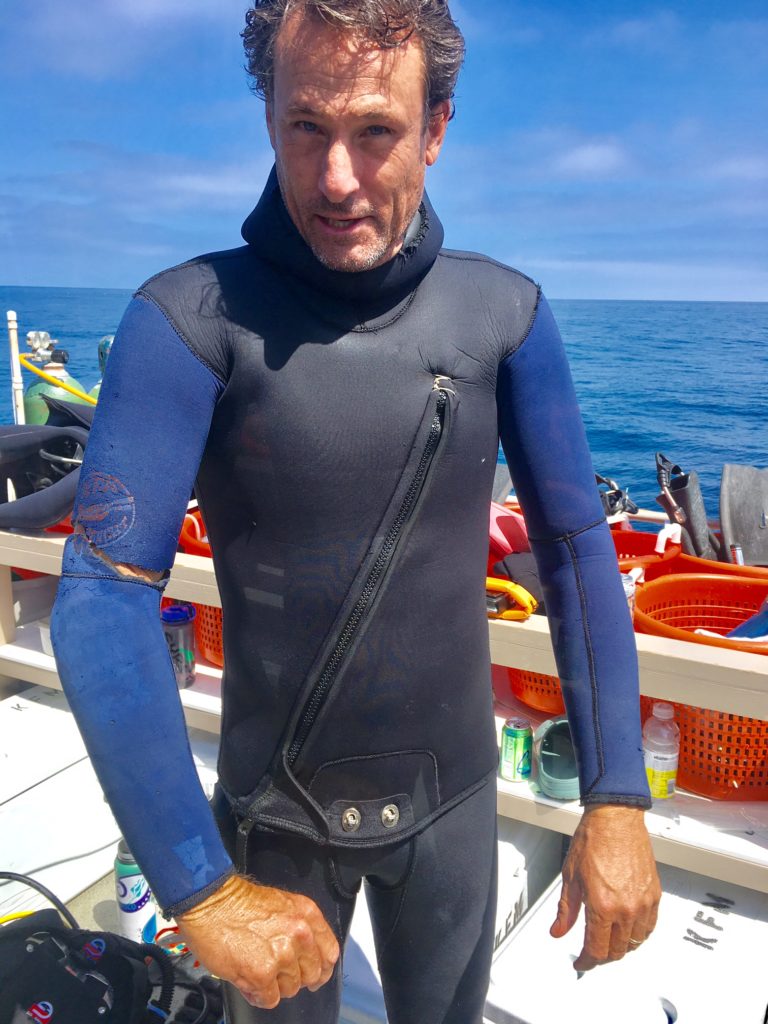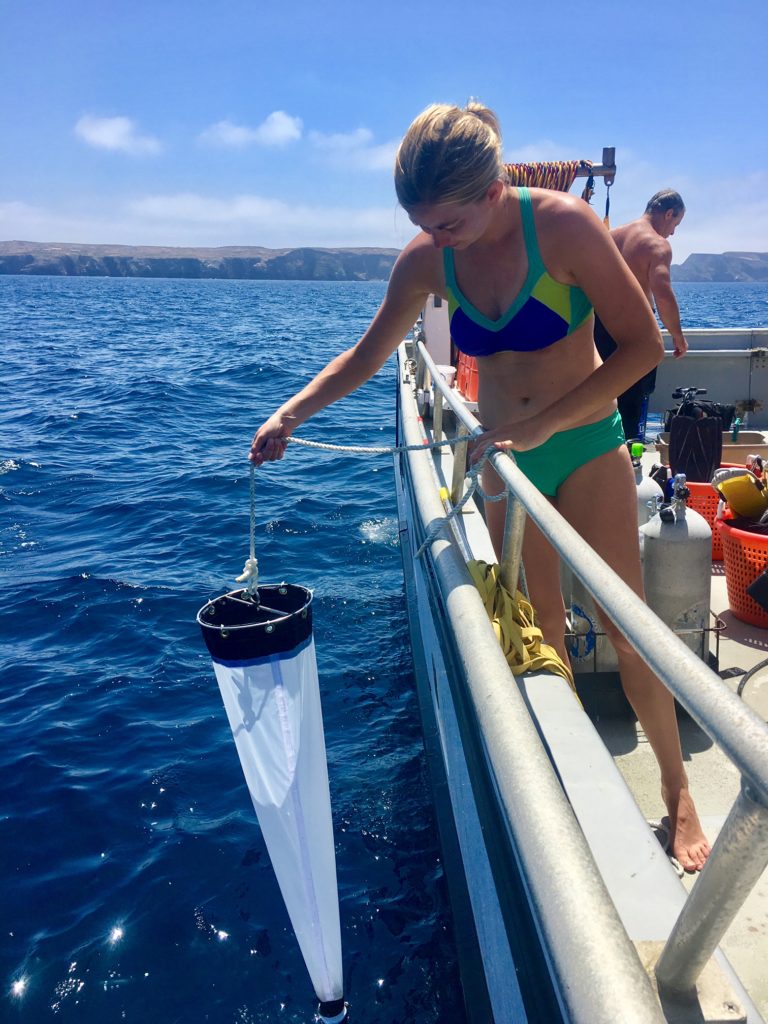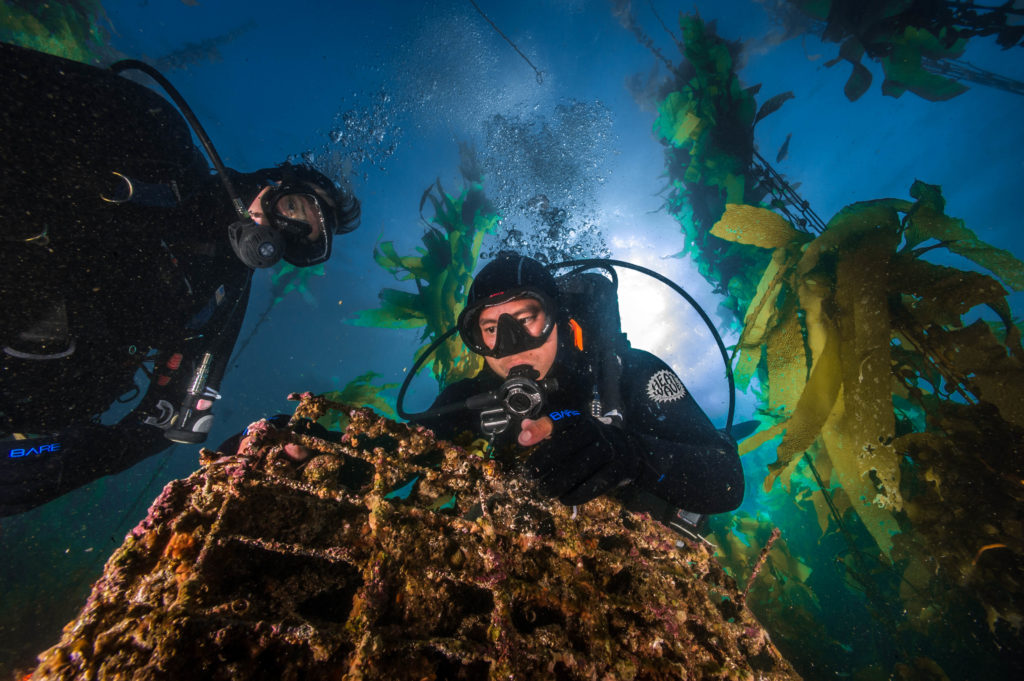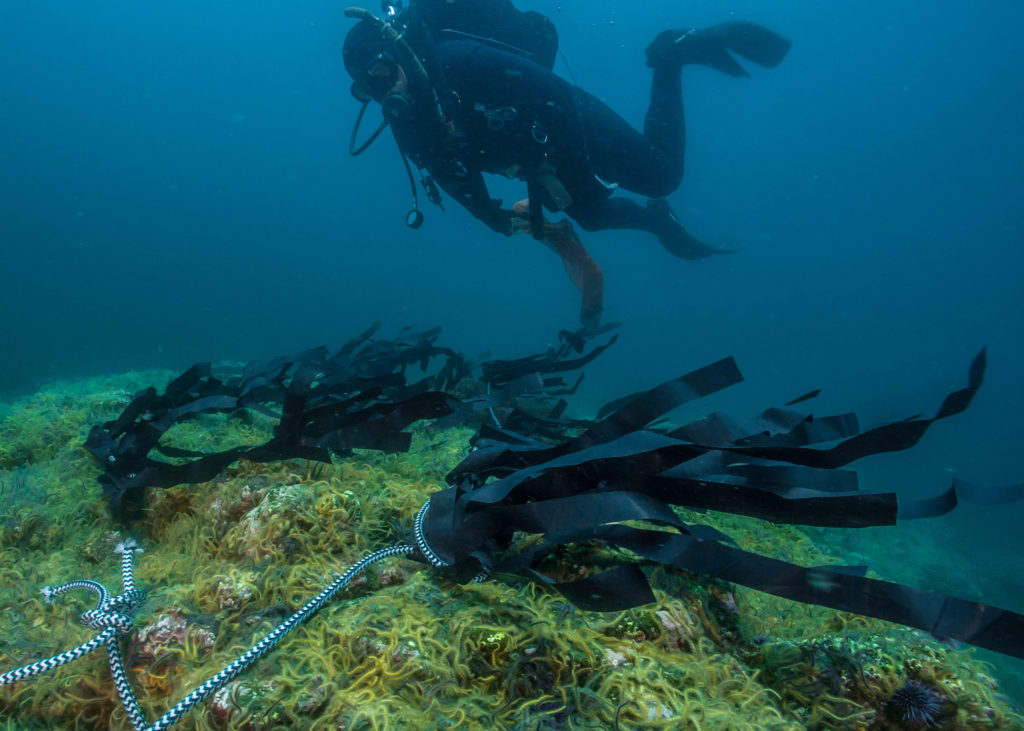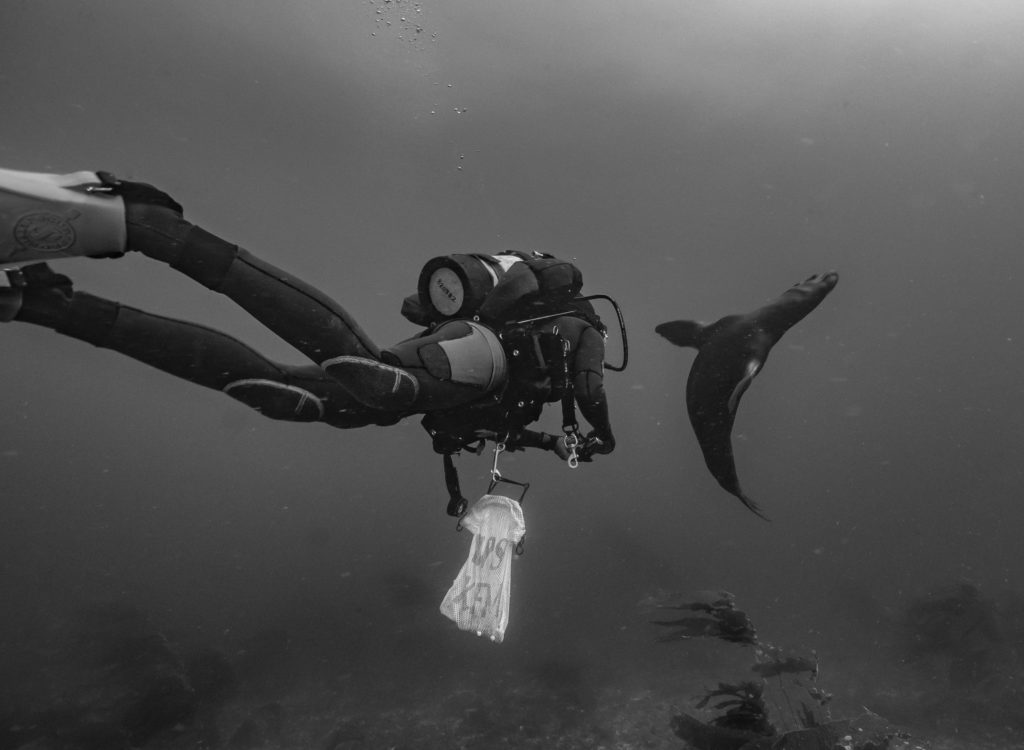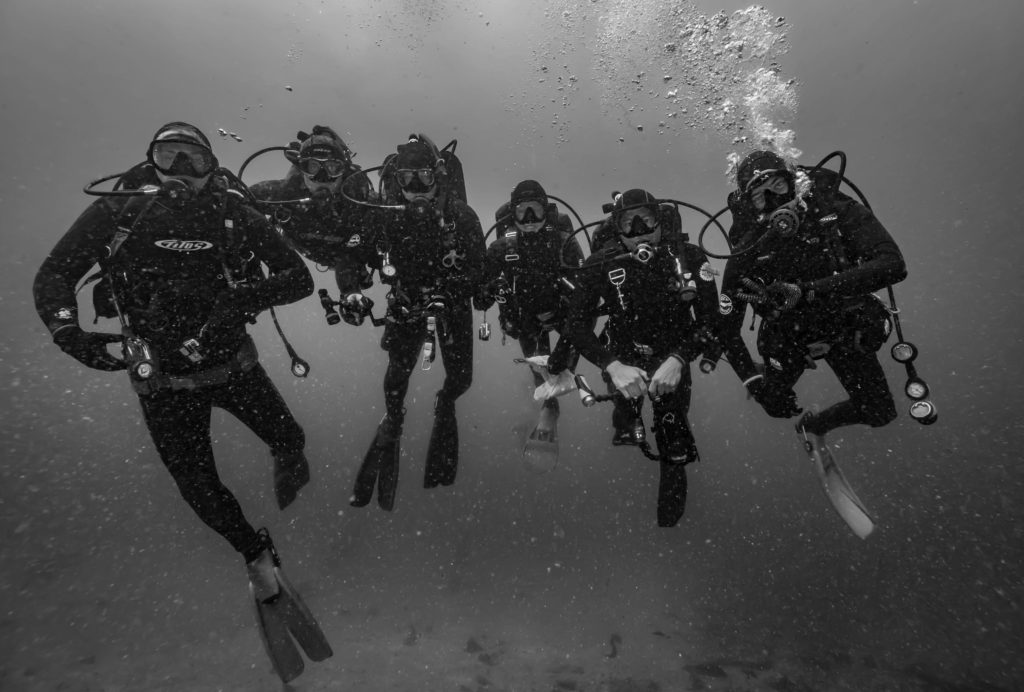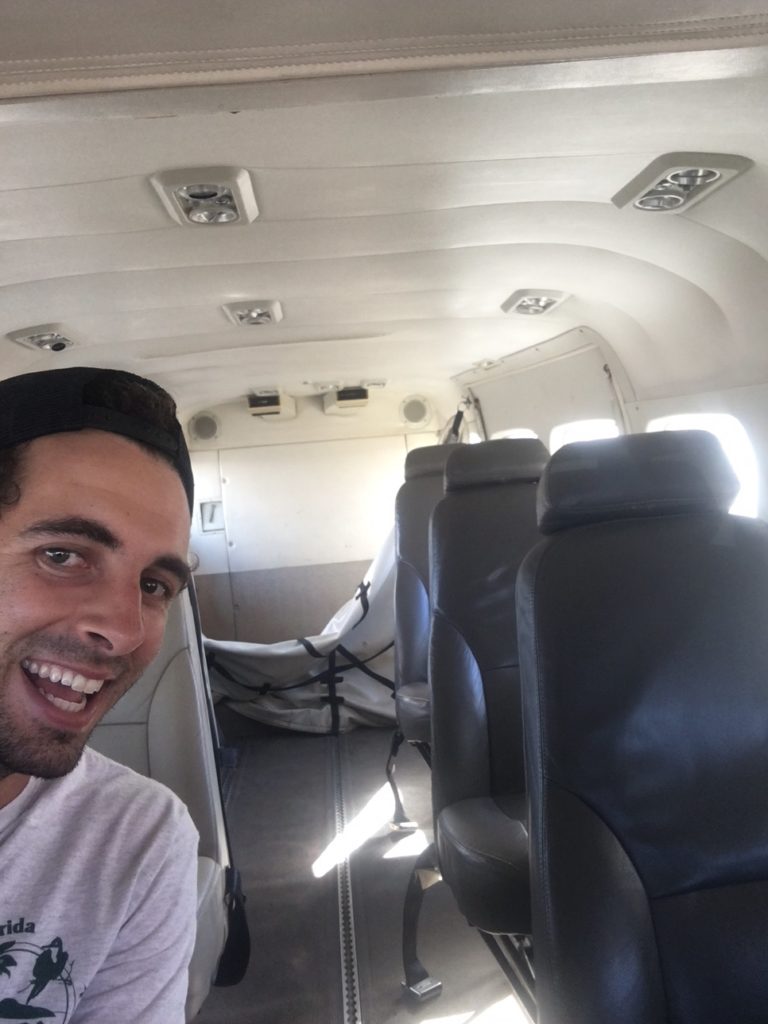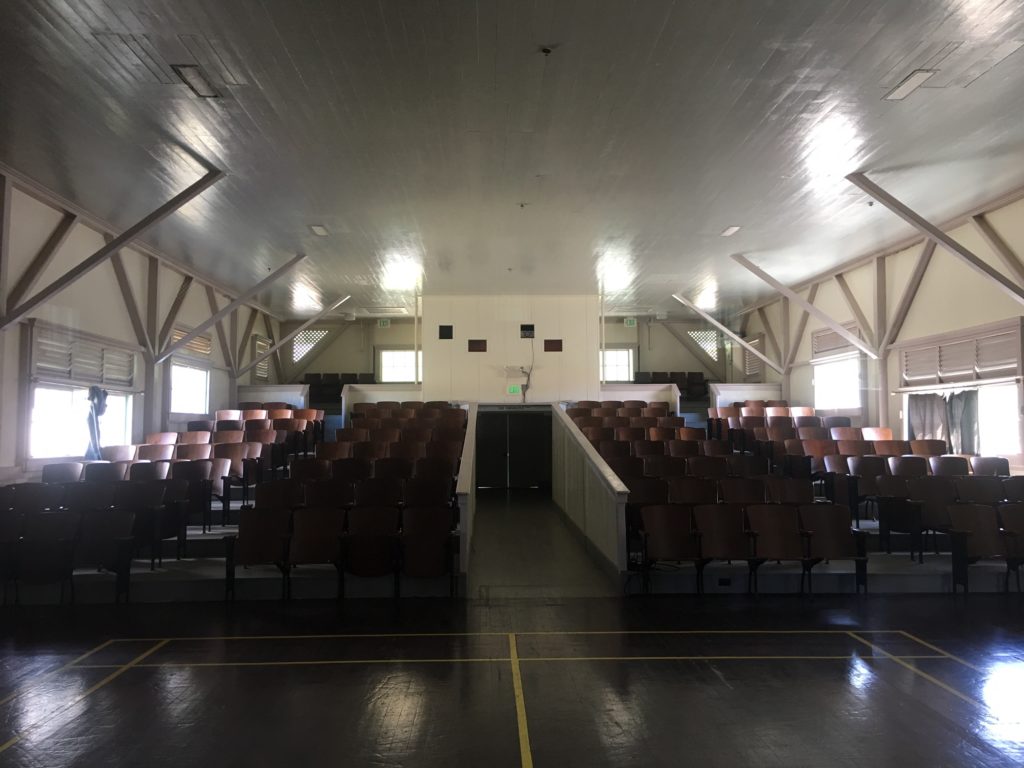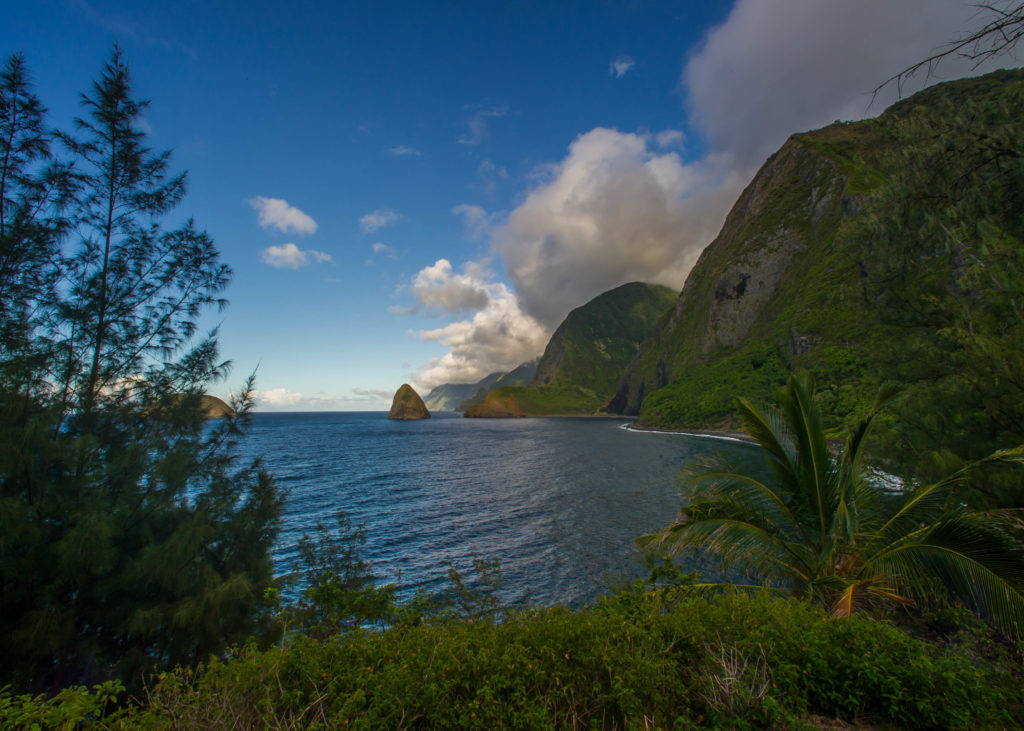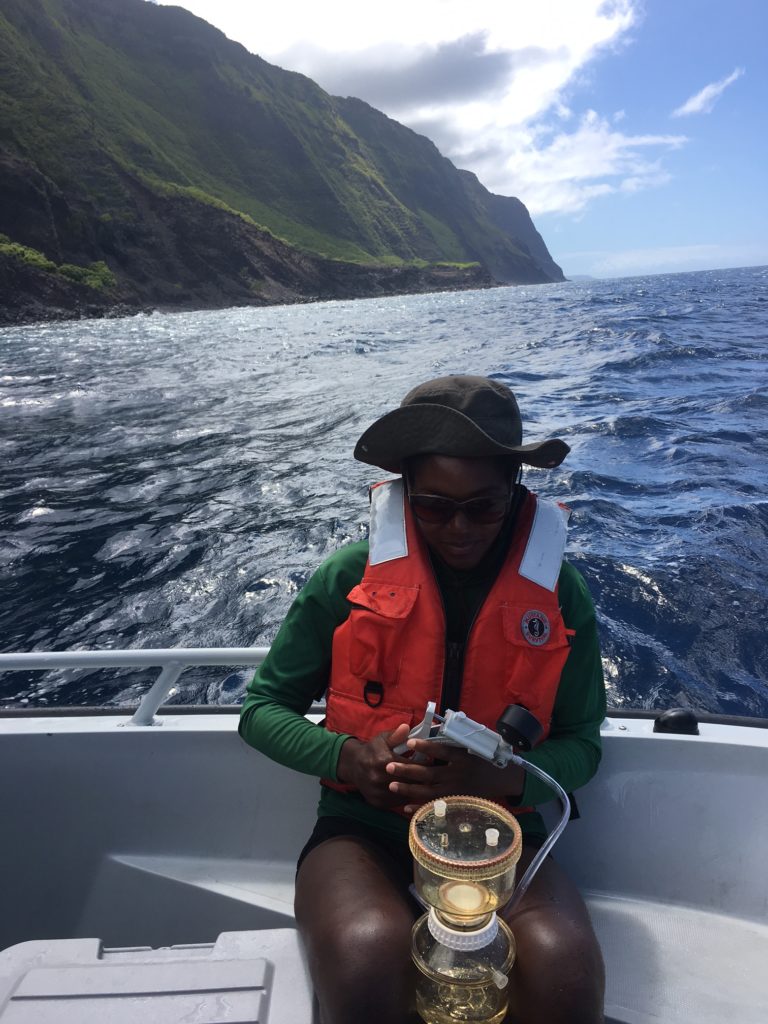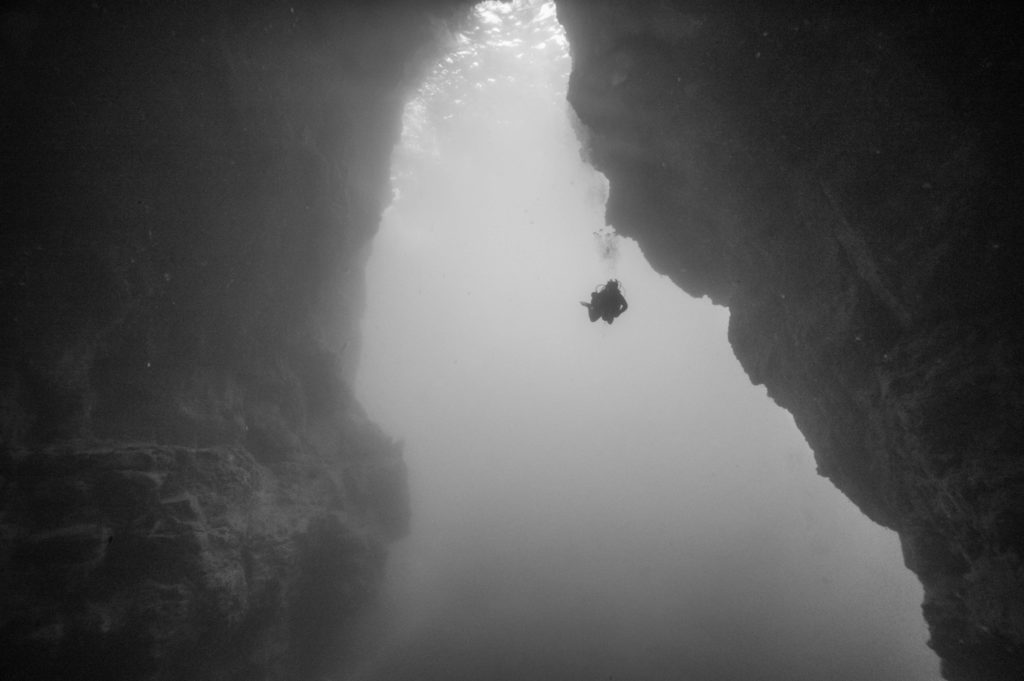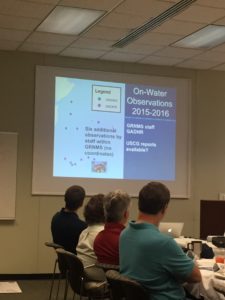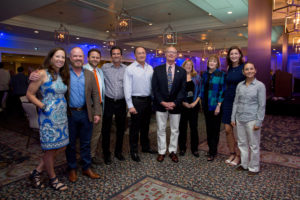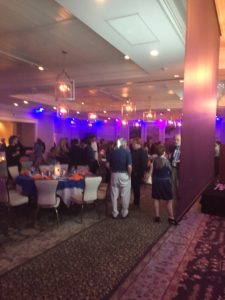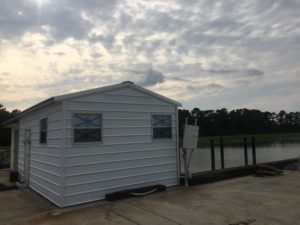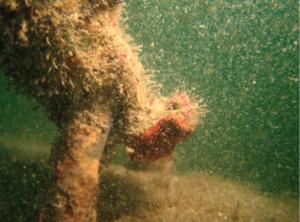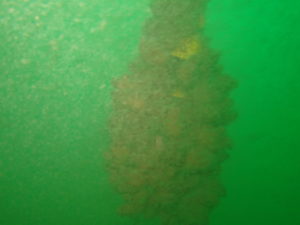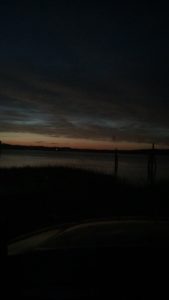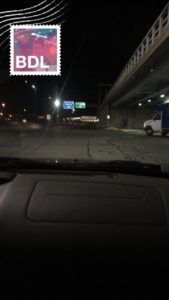“That’s the last flight of the day, your luggage will probably come in tomorrow. What hotel are you staying at?” a sea plane employee tells me on St. Thomas. “I’m not staying in a hotel. I’m supposed to be in St. John right now,” I respond. I have been waiting in the sea plane terminal in downtown Charlotte Amalie for 3 hours for my camera gear that won’t be coming in today. I’m more than a little bit concerned. The camera gear is incredibly valuable and it’s not mine. Furthermore, I’m supposed to start work on a boat tomorrow morning on St. John.

The sea plane ride was beautiful, but proved costly.
Phone service is spotty at best in the U.S. Virgin Islands. I try calling a few people that I know on St. John, and get finally get ahold of someone. “Good grief, well, welcome to the Virgin Islands!” Jeff says after hearing my story. “No worries, do what you need to do, get your luggage, and we’ll see you tomorrow evening back at the dock.”Luckily for me, I know some people on St. Thomas as well. I meet my friend Lora, who grew up with me on Catalina Island, for some dinner downtown and she takes me across the island to the Red Hook area.
Life in the Caribbean, particularly St. Thomas, is a paradox. It is very laid back and incredibly frantic all at the same time. Music blares out of cars weaving in and out of traffic on busted roads while the weather switches constantly between brutal heat and pouring rain, but no one really has an issues with it. As we approach where I’ll be staying for the night, I get a text from Andy Davis. “Hey brother, I won’t be back at the condo when you arrive. Joey Contillo is there.” I worked with Andy at Dry Tortugas National Park. He is a member of the South Florida Caribbean Network (SFCN) monitoring team and offered me a couch to crash on for the night.
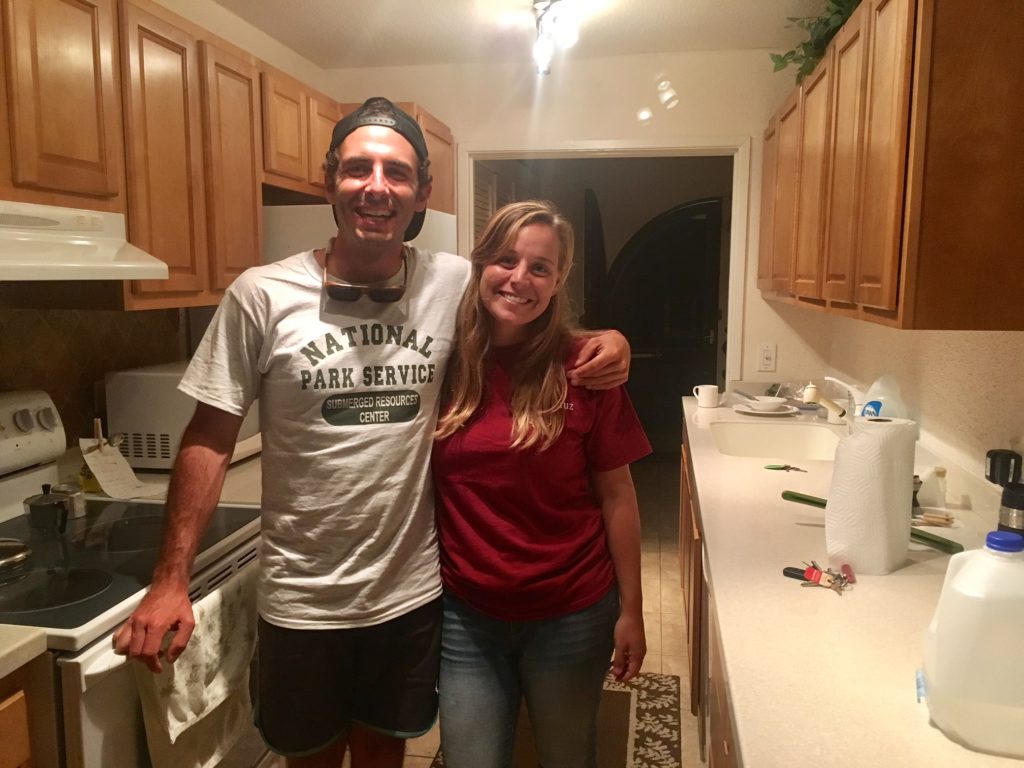
Lora and I in my St. Thomas residence for the evening.
Lora and I pull up to the condo and see a shoeless man outside. He is extremely tan, has a long blonde ponytail, and looks like he’s been on the water everyday for the past 20 years. “Is that your guy?” Lora asks me. I tell her that I don’t think it is. We spend a few minutes grabbing my gear and head to the front door. I knock three times. “Delivery?” someone inside says. I respond, “no?” The blonde tan man that we saw earlier walks casually toward us from the other side of the screen door. “Sorry man, I’ve been waiting on a food deliver. I’m starving!” he says. “No worries, I’m Shaun. Did Andy get a chance to tell you about me yet?” I ask. “No, I don’t think so,” he ponders. “Well, umm, I’m staying with you guys tonight,” I inform him. “Right on! Come on in!” Turns out, this is Joey Contillo. One of the most senior members of NOAA’s dive team, with personality as laid back as he looks. Also turns out that Lora knows him and my other housemate for the night, Laughlin Siceloff. They all worked together on the National Coral Reef Monitoring Program (NCRMP) on St. Thomas last year and Joey and Laughlin are working on NCRMP right now on St. Thomas.
As Joey chows down on his delivery food and Laughlin fires up Game of Thrones on the TV, we all chat and get to know each other. As Andy arrives, Lora leaves. I say my goodbye to my old island friend and greet Andy as we get ready for bed. I am incredibly thankful for Andy, Laughlin, and Joey taking me in, being stranded on St. Thomas for the night, and Lora for driving me an hour over to the east side of the island.
I’m at the Red Hook ferry terminal slapping mosquitos in the heat and talking to local cab drivers about how they never make money driving people all the way to the airport. I can barely understand some of them through their thick Caribbean accents. A cab driver pulls in and walks around looking for someone. I think it’s me, so I go up and ask. “Can I see your ID please?” he asks in return. I show him and he says, “follow me.” He has my camera gear. I had debated calling my supervisor (Brett Seymour) to let him know that I didn’t have my camera gear and didn’t know exactly where it was. I didn’t, figuring it’d be best not to get him involved unless it didn’t come in today. Glad I didn’t call him!

Kelly O’Connell, subsurface.
Upon arriving at the terminal on St. John, Kelly O’Connell (SFCN intern from the Dry Tortugas blog) picks me up. After grabbing groceries, she takes me up to the “Biosphere,” the name of U.S. Virgin Islands National Park headquarters.

The view of Cruz Bay from my window at the biosphere.
As soon as we pull in, I hear someone shout “Shaun!” like they are about to get crushed by a heavy object and need my help moving it. Then I hear someone else shout it the same way. It’s Lee Richter and Mike Feeley (SFCN team members) saying my “nickname” from my time at Dry Tortugas National Park. “Come here divers!!” I say as I give them both a big hug and help unload their dive gear for the day. Hugging Mike is always a challenge, since he’s about 6’4” and I’m a meager 5’9”. I’m extremely excited to see these guys and be able to work with them. I really bonded with the SFCN team at Dry Tortugas and this feels like a homecoming of sorts.
I’m here in St. John to help with NCRMP. NCRMP takes place on all of the Virgin Islands every year. It is a big multi-year multi-agency project between the National Park Service, Environmental Protection Agency (EPA), the National Oceanic and Atmospheric Atmosphere (NOAA), and several universities. The NCRMP teams take data on the health of the reef systems around the islands, including reef fish populations, coral growth and abundance, and water quality. By taking this data year after year, they can see whether the coral reefs and fish populations are growing or shrinking and whether water quality is improving or not. When compared with weather and temperature records along with policy and management decisions, the NCRMP study can inform managers and law enforcement of how their decisions are impacting the health of the parks’ natural resources (which in turn affects the entire region’s natural resources).

NPS, NOAA, and EPA are represented on every boat. Here we have (L-R) Lee Richter (NPS), Myself, Jeff “J Mills” Miller (NPS), Debbie Santavy (EPA), Caitlin “T Dubs” Langwiser (NOAA), and Shay Neve (NOAA). Photo Credit: Jay Grove / NOAA.
Once we get all the gear rinsed and put away, we head out to meet some of the rest of the team for dinner. “Shaun!” Rob Waara shouts, in only the way that an SFCN team member can. We hug it out while I meet Jay Grove and Caitlin Langwiser from NOAA. Caitlyn was an intern for SFCN a few years prior and now works for NOAA. Like many others in the Caribbean, Caitlin is a “Nutmegger,” or someone from Connecticut. She is quick-witted, always positive, and has the most unbelievable air consumption underwater that you will ever witness.

Rob Waara at an SCR site…my favorite kind.
Rob takes out a bunch of genips, a small tropical fruit that I love, while Jay tells us how allergic she is to tropical fruit- especially mangos. Not a minute after, a mango drink that is on the table tips over and spills all over Jay. Jay laughs and is a good sport about it. “Secretly, I can feel the hives breaking out,” she says half-jokingly. “Jay, you’re not going to be able to dive with us tomorrow! You won’t be able to get into your wetsuit once you’re all swelled up!” Rob chimes in as we all laugh. This is a such a classic SFCN moment. I missed these guys.

Jay Grove underwater, once the mango hives wore off.
“Always Alert, Never Hurt…sounds like a Thomas Kelly catch phrase,” Caitlyn says. The phrase is displayed on the Acropora, the boat I am on today with Caitlyn, Jeff, Lee, Debbie Harris (EPA), and Shay Neve (NOAA). We get to the boat after Randy gives the entire team our morning brief and introduces me to everyone. It is a pretty awe-inspiring operation. NCRMP is happening on St. Thomas and St. John concurrently, involves three different organizations (NPS, EPA, and NOAA), and draws on staff that live as far as New Orleans and Maryland. Since the surveys require an intimate knowledge of both Caribbean fish and coral species (which I do not have), I have been assigned to take photos for the team. I will be hopping boat to boat during my time in St. John to try to get as many photos of as many different teams as possible.

Me living up to the motto, “always alert, never hurt.” Photo credit: Jay Grove / NOAA
One of the biggest issues that the science community faces, and the one that I am most interested in, is how can we effectively communicate with the general public? While I have many thoughts on this broadly, specifically, the first step for this team in communication is simply to let the public know what they are doing. A photo can tell that story more quickly and effectively than a press release. It’s easier (and let’s admit it, more fun) to consume. Needless to say, I’m excited to get going on my photo tasks.

The NCRMP team. Front (L-R): Myself and Caitlin Langwiser. Middle (L-R): Debbie Santavy, Cheryl Hankins, Peggy Harris, Shay Neve, Jay Grove, Kelly O’Connell, Mark Monaco. Rear (L-R): Matt Johnson, Justine Kimball, Lee Richter, Adam Glahn, Thomas Kelly, Randy Clark, Jeff Miller, Mike Feeley.
As I grab the last cylinder to load onto the boat, I’m followed by Jay Grove, or as I’ve begun to call her “J-groove.” “I’m coming with you for moral support!” she says, as I huck the cylinder on my shoulder.

Because the sites were so uninteresting, I tried to use the sun for a bit of fun. Here’s Shay Neve with her data sheet.
The first two sites that we go to are classified as “SCR,” or scattered coral rock. SCR sites are unanimously the least liked sites. It’s not hard to see why- the sites are essentially rubble formed from dead and broken coral on a homogenous, flat bottom.

These sorts of soft corals are non-existent at SCR sites.
Shooting in this kind of environment is a challenge for me. It’s hard for me to make a photo visually interesting when there is so little that is inherently visually interesting in the environment. The third site that we go to is extremely shallow. “What’s the depth on this one?” Lee asks as wind-driven little waves lap past the hull. “3 feet, you guys are going to have to swim in a bit from the drop off point,” Jeff responds, fearing the possibility of running the boat aground.
Turns out, the site really is 3 feet deep. It’s a challenge for the whole team to try to stay down while minding hard corals in the area. That being said, it’s the most dynamic environment we have seen all day and I’m pretty happy to be there.
“When it comes to us that live here in the VI, we are all out here, but we aren’t all here,” Thomas Kelly tells me during a surface interval. Thomas is the Chief of Natural Resources at Virgin Islands National Park. Sporting a serious mustache, Thomas is a well-liked leader within NPS. He leads by example, working long hours and always staying level-headed. He is also quite the history buff when it comes to St. John in particular.
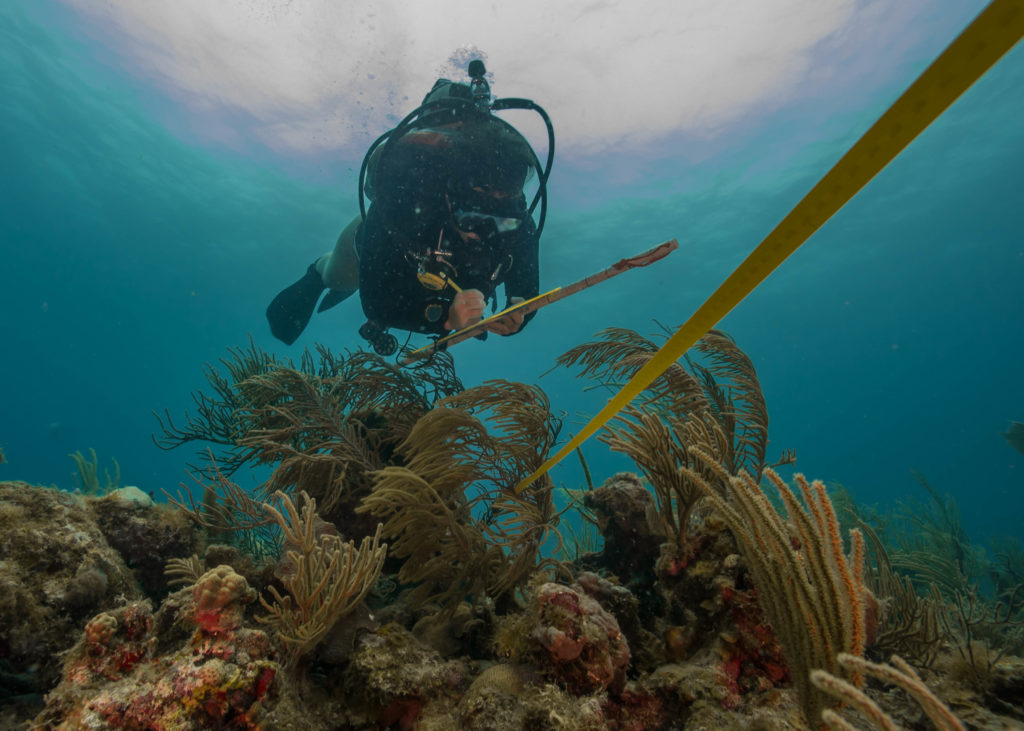
Kelly O’Connell runs a benthic survey.
Also on the boat with us is Kelly, Mike, Cheryl Hankins (EPA), and Matt Johnson (NOAA). Cheryl is responsible for taking water samples at many of the sites we visit. While the rest of the team largely focuses on the health of fish stocks and corals over time, Cheryl’s water quality data can help answer the question of why. For example, why have corals recovered in these two bays but not the third? Though water quality cannot be ordained as the single reason why, Cheryl hopes to find out how big of a role it plays in the health of the ecosystems around St. John.
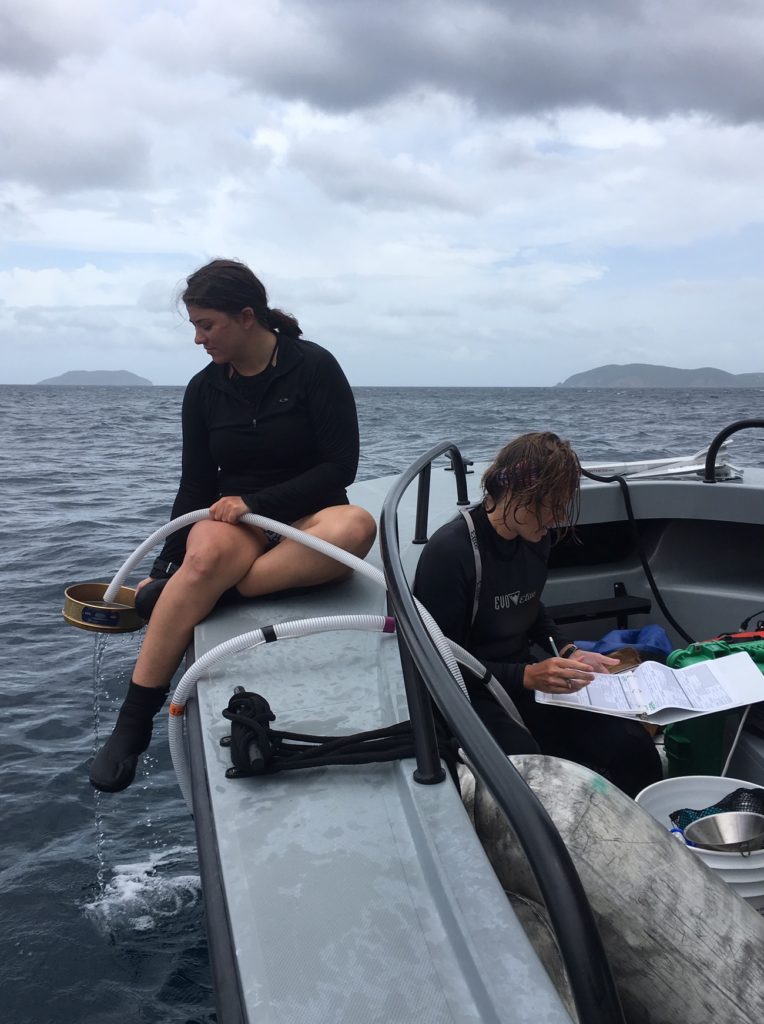
Kelly O’Connell and Cheryl taking water quality samples.
After struggling with a few sites that had strong current, big waves, and whipping wind, we head to a more protected spot behind the shelter of some magnificent jagged rocks offshore a bit. This is a bedrock site, so it should have more interesting structure. Once underwater, I take some photos of Kelly and Cheryl while they run benthic (sea floor) surveys. I’m not allowed to go near the fish survey team until they finish their survey. I can skew their data by scaring fish into or out of their survey area.

Kelly and Cheryl tag team a benthic survey.
I get a few shots of Cheryl and Kelly that I like, so I begin exploring the site. I swim to the backside of the site where there are three distinct and fairly dramatic underwater slot canyons. I signal to Mike that I want him to come over when he can. I try to explain, using hand signals, the shot that I have envisioned in my head. Admittedly, I’m still learning how best to communicate staged photo ideas underwater with my hands, which Mike found out quickly.

The underwater structure at this site was incredible.
“I can’t believe I messed up the tunnel shot!” Mike exclaims back on the boat. Mike not-so-secretly really enjoys photography. He isn’t explicit about it, but he lights up when he sees a good image or takes a nice shot himself. Hence, he is always up for helping me out as a photographer. “I couldn’t figure out exactly what you wanted. Man, that tunnel was so cool, I can’t believe I messed up the tunnel shot!” I assure him that we’ll find something else equally as cool to photograph later on.
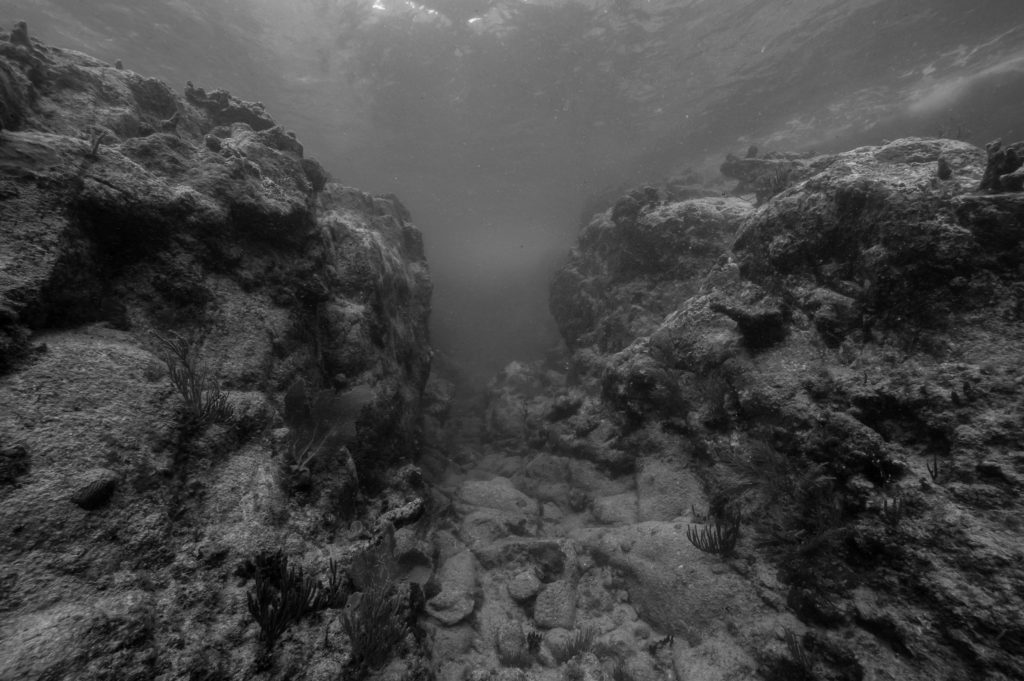
The shallow part of “the tunnel.”
On our next dive, it’s more of the same on my end. I take photos of the team performing different surveys, trying to show the methods they are using in a way that someone looking at the picture can understand. After the fish survey team is done, Mike signals to me to come over. He points out some fish that caught his eye- dog snapper, giant porcupine, and a few indigo hamlets. I think that Mike figured it out pretty quickly at Dry Tortugas. I am a fish guy. Corals are wonderful creatures and the backbone of tropical ecosystems, but from childhood, I’ve always been a fish guy. My earliest memories of wanting to go into marine science came from looking at fish in buckets that fishermen on local piers would catch. Mike is also a fish guy, so anytime that either of us see an interesting fish, we point it out to one another. Of course, he has a much better idea of what makes a fish interesting in the Caribbean than I do.
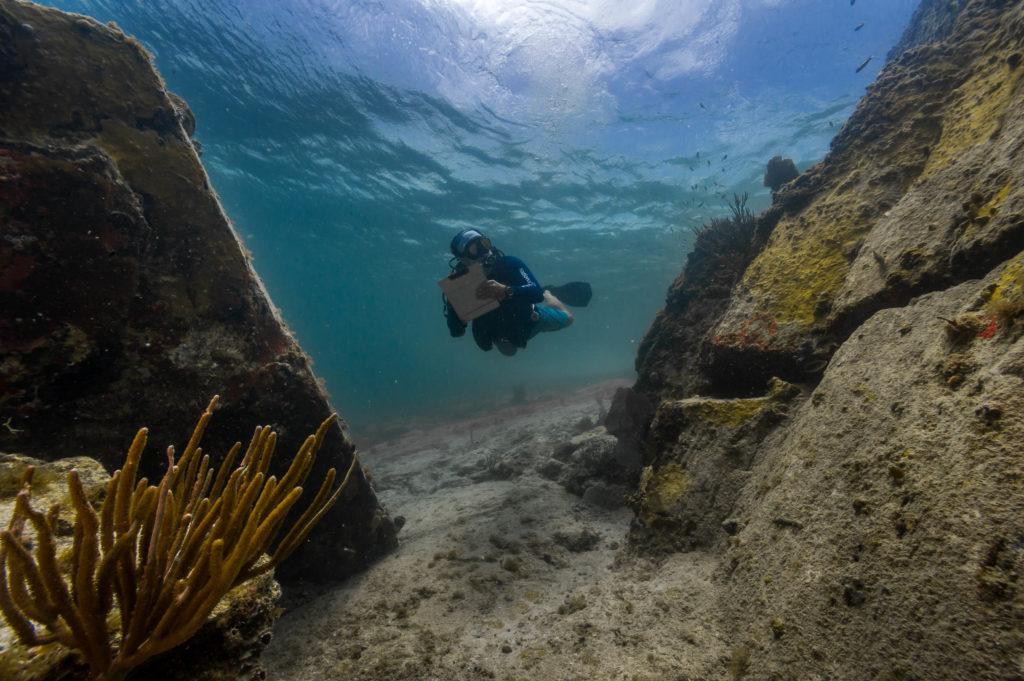
Mike Feeley- a fishy guy completing a fishy survey.
Thomas also pointed out a fish to me- a juvenile spotted drum. It is truly an incredible fish. The size of a thumbnail, with huge ribbon-like streamers coming off the top and bottom of its body. Watching the fish swim is like watching a talented gymnast perform a flag floor routine. Because of its small size, I can’t get a photo of it, but it will forever stick in my memory.

Even the smallest corals get measured!
Back on board, we secure the deck and head to St. Thomas to get our nitrox cylinders filled. There is only one dive shop on St. John and they don’t have the ability to fill nitrox. We arrive to be greeted by Andy Davis who out of his way to say hi and help us unload after diving the full day himself, pretty telling of his character.

“That’s an aggressive stance!” Thomas Kelly tells me in regard to this iguana charging me while I take this photo.
We are waiting for the cylinders to finish filling and Thomas is taking a phone call. Kelly is cracking up, “Tom’s getting charged by that iguana!” I see an iguana racing towards Thomas. He stamps his foot and hollers at it to scare it off as we are all laughing at this point.

Being the one with the camera, I have very few shots of myself at work underwater. Here’s one Mike Feeley snagged!
It’s 7 PM in St. John’s Cruz Bay. It’s really the only “town” on the island and it’s center is small, but full of life. Myself and many members of the NCRMP team are out to dinner. Justine Kimball (NOAA) is there as well. I’ve been crossing paths with Justine for the entire week but haven’t actually been able to talk to her. She is in charge of this NCRMP mission.
“Half Moon Bay?! Home of the famous Mavericks?!” I exclaim upon finding out that Justine is a Californian as well. It’s fairly uncommon to meet Californians in the Caribbean, so I relish in meeting my fellow west coast friends when it happens. Not only is she from California, but she went to school at UC Santa Barbara, where I am currently enrolled. Justine is particularly interested in my photos, since she wants to make NCRMP more visible and get the mission a little more publicity. It’s fulfilling to come to a park where the park (and in this case EPA and NOAA) are interested in using the photos that I’m taking. It certainly makes me feel like I’m contributing something unique.
“You’re going to get some great photos here in Coral Bay today. You’re going to love it, great vis, 5 feet at least,” Rob tells me. Today I’m diving the south side of the island (a departure from the other days I’ve been here) with Jay, Rob, Mark Monaco (NOAA), Adam Glahn (NPS), and Peggy Harris (EPA). As Rob predicted, the water is extremely green and murky. Once we drop down, the fish survey team aborts the dive. The poor visibility inhibits them from taking a proper fish survey. The surveys are done by a diver who records all fish within an imaginary 7m radius cylinder around them. If they can’t see the fish in that 7m, than the survey method doesn’t work.

Jay Grove drops into Coral Bay, while the color-coordinated Peggy Harris waits her turn.
While we wait we wait on the surface for the benthic survey team, we find a way to pass time. “It’s a cool one, it’s French I think,” Jay says in deep thought, “Des Moines!” We all groan and can’t believe we forgot the capital of Iowa. “Ok, Kentucky,” Mark announces. As we try to guess more state capitals, the benthic team surfaces. “Frankfurt!” Jay exclaims. “As you can tell, you guys really missed out on some exciting times topside,” Mark tells the benthic team. Peggy hops back on board and I take a minute to admire her color-coordinated dive gear. Her fins, mask, snorkel, wetsuit, BCD, and head band are all pink. Quite the fashionable feat really.
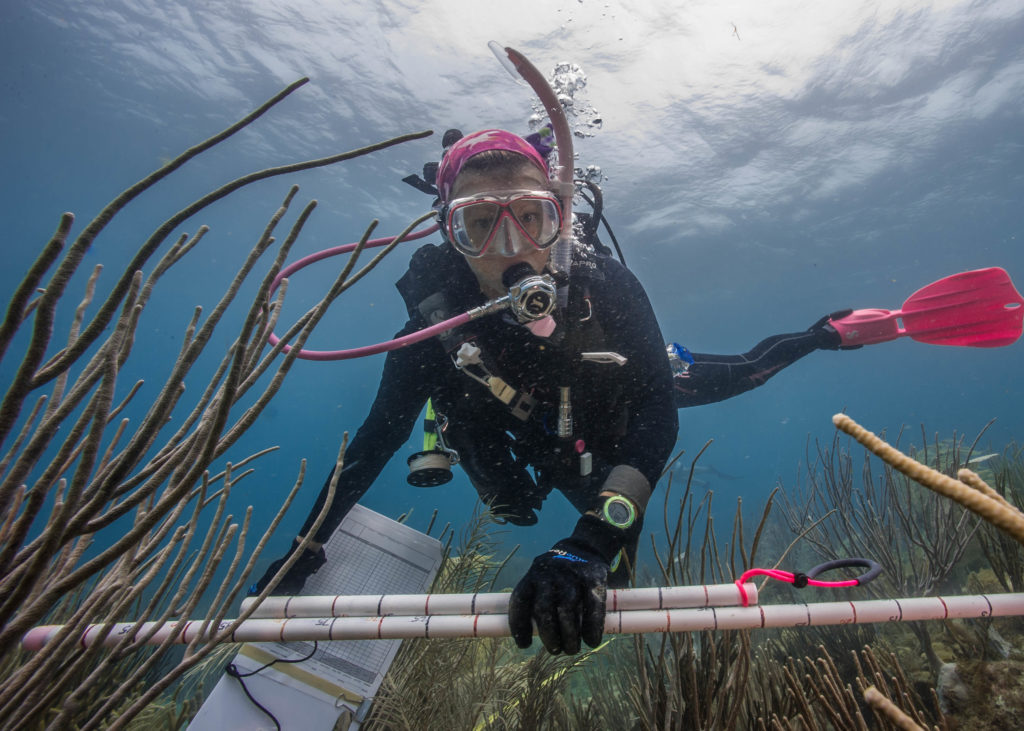
Peggy preps for a benthic survey.
We finish one more murky site and then meet with Mike Feeley to give him our used cylinders that his boat will then take into St. Thomas. Our next site is much more clear and provides me with the first useable photos of the day. “Nice work down there guys!” Rob says to Jay and I. “Well, us Scorpios are known for our high quality work,” Jay responds. Jay and I have been joking all week about being a Scorpio. Our astrological sign seemingly gets the short end of the stick when it comes to redeeming qualities. We try to prop up our sign at every possible turn when someone compliments us. Besides being a Scorpio, Jay is quite the jokester and speaks as quickly as her New England roots would dictate. She can find the comedy in anything, which keeps her smiling all the time.

Strangely, this was the first sting ray I saw all summer.
Our last dive of the day signals the end of diving for NCRMP and my last dive in the Caribbean. I’m going to miss diving in a rash guard and board shorts at my next stop in California.
“Shaun!” Lee shouts in the way the SFCN guys say my name, “there may be an opportunity to get on a surfboard before dinner if you’re interested.” “Done, when are we leaving?” I reply. We are waiting on Lee’s car to arrive. After about 30 minutes, Lee gets a little pessimistic. “I may have gotten a little ambitious, we certainly aren’t going to have much time,” he voices his concern to me. I encourage Lee, who doesn’t need much encouragement, and say, “it’s always worth it!” Lee is a lot like myself in many ways, and doesn’t need much convincing when it comes to doing something outside.

Colorful tunicates and sponges are common underneath rocky overhangs.
After a catching some really fun, tiny waves that we had all to ourselves, we head to the first of two final dinners. At the table, I ask Caitlyn about her nickname. SFCN loves to give nicknames to their interns. They say my name in the funny way they do, Kelly is known as “R. Kelly” (after the rapper), and Caitlyn was lovingly given the nickname “trainwreck,” or “T Dubs” for short. She was given this name not because of her work or tendencies in the field, but because of the oddly comedic and slightly tragic events that happen to her (and could only happen to her) in her daily life. “When I was about 12, I was doing a long road trip with my dad and the back windows of the car were rolled down a little less than halfway. We are driving along, enjoying the scenery when a bird flies in through the window, slams straight into my head, and dies immediately in my lap. I’m scared, confused, and a little emotionally scarred with a dead bird in my lap. I am balling, crying, and telling my dad that there is a dead bird in my lap. He’s convinced that there isn’t, so we just keep driving,” she tells us while we erupt into laughter.
It’s the last day that the NCRMP team is in St. John. I decide to go on a hike with Lee, who knows the trails in the park better than most island residents. He picks me up and we make a stop at the pharmacy for me. I need to pick up thank you cards and Jeff told me my best bet is the pharmacy. After strolling through the card section, I ask an employee if they sell thank you cards in packs of 10 or so. They usually do, but don’t right now. They only have one pack of any kind of card right now, and it is a religious card that has a cross on the front and the words “In Celebration” beneath it. I debate whether I should buy them. Deciding they are likely blank inside, I buy them thinking I can work with that.

Lee Richter capturing my best Tarzan impression on our way up Fish Bay Gut.
20 minutes later, Lee and I are hiking up Fish Bay Gut- a boulder ravine full of mild rock scrambles. Lee points out edible and harmful plants along the way and I’m very entertained by the creative nature of the islander naming convention. “This one looks like a pineapple plant, but isn’t. The fruits are small and taste fairly similar to pineapples. It’s called ‘false pineapple.’” Further along, my hat gets caught on a sharp vine and stays there as I walk past. “This one is called grab and keep, you can see why.”

Taino petroglyphs.
On our ascent, we talk sports, relationships, careers, and everything in between. Lee is an amazing guy who, at this point, I see as a friend first and a colleague second. The rest of the hike is filled with Danish roads, sugar mill ruins, Taino petroglyphs, and dry waterfalls. “This is some heart of St. John stuff right here, few visitors do this kind of stuff,” Lee remarks.
-

-
Some of the equipment from the original factory is still on display in the ruins.
-

-
The light that comes in through the tattered ceiling of the ruins can be a little creepy. The bats hanging from the ceiling don’t help the creep factor.
-

-
The National Park Service does an incredible job preserving these historical buildings.
Back at Lee’s place, we get ready for our last night out with the NCRMP team. I take out my religious “In Celebration” cards to start writing thank you notes for the NCRMP team that brought me out to the island. “Oh boy. These are actually event invitation cards and they are pretty religious. Wow. I’m not sure I can use these,” I say to Lee. The cards are not blank like I thought they would be. They have lines for date, time, occasion, place, and RSVP. At the bottom it says “Praise the Lord! Psalms 52:1.” “I think you could, you just have to play it up right,” Lee convinces me. “Well, they will certainly remember me and it’s all I have, so I’m going with it!”
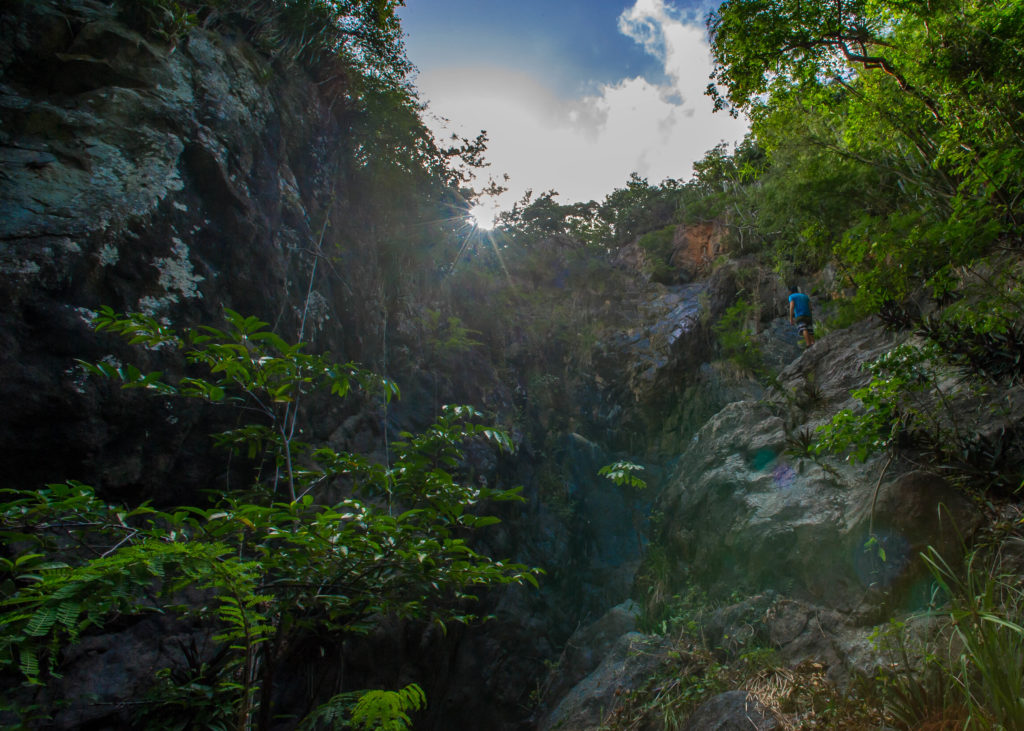
The dramatic landscape of St. John.
“This is ‘B-‘ material,” Caitlyn criticizes my card jokingly, “an invitation card with no invitation!” she says jokingly. The cards end up going over quite well with the team. Our final night is lots of fun and a great opportunity to chat with everyone that I may not have seen as much throughout NCRMP. There are challenges of bringing three agencies together to work on a project. Each agency has their own protocols, schedule, and have staff that are based in different and distant locations. However, the NCRMP team seemed to work seamlessly throughout the week. I believe it’s because this group of people enjoys each other on and off the water. Everyone gets together almost every night to tell stories and share laughs. The synergy goes past the point of functionality and is really something for any other inter-agency project to aspire to.
As I prepped to head out in the morning, Mike Feeley gave me his hooded vest so I could stay a bit warmer back west. I thanked him in particular for having me out a second time. I already felt strongly about my connection with the SFCN team after Dry Tortugas, and that has only grown stronger here in St. John.
-

-
On the way out of St. John and into Miami, I passed by some incredible land and seascapes. I didn’t have my camera on me, but managed to snap a few pictures with my iPhone.
-
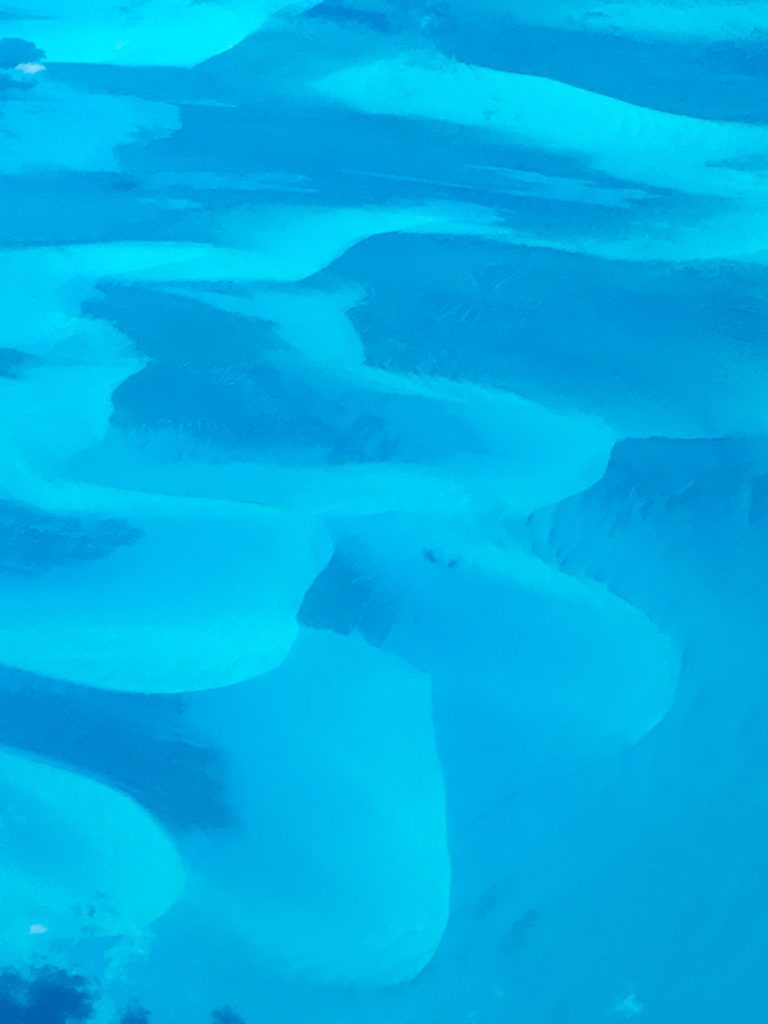
-
This is the ocean and the patterns are a result of sandbars.
-

-

I’m going to miss all of the NCRMP team and SFCN in particular as I head west. I will certainly miss warm waters and the ease of diving without a wetsuit when I’m covered in 12mm of neoprene at my next stop. Though admittedly, I’m excited to head back to Channel Islands. It’s the National Park that started it all for me. So until next time, this is “Shaun!” signing off from the Caribbean.

Kelly O’Connell peaces out after a week of NCRMP!
















